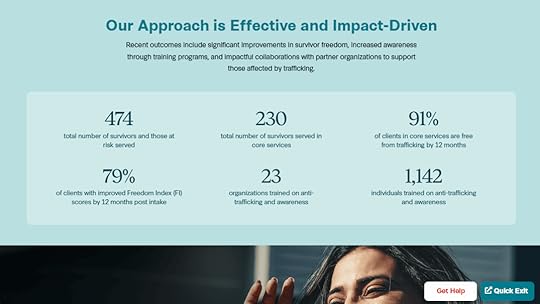4 Reasons Your Donors Aren’t Engaging With Your Website
Imagine this: A donor mentions your nonprofit during a casual conversation with a family member, sparking an interest in your cause. Later that day, the family member looks up your organization online, hoping to learn how they can get involved. However, after seeing your home page, they navigate away without taking any action at all.
First impressions matter, which means your nonprofitâs website can make or break a donorâs relationship with your organization. If you donât make it easy for donors to understand what you do, explore how they can support your cause, and donate, chances are theyâll find another nonprofit that does.
Letâs explore the top reasons donors arenât engaging with your website and the concrete steps you can take to improve it.
1. Poor User Experience (UX)Does your website take several long seconds to load? When donors land on your homepage, do they have to dig through your navigation to find where theyâre trying to go? Are there too many images, buttons, and blocks of text crowding your pages?
Your nonprofitâs website is one of your most powerful marketing tools, but only if it has a strong user experience (UX).
Next StepsUse free tools such as PageSpeed Insights to identify if your website has UX issues. Compile your findings and start implementing improvements such as:
Simplifying the navigation barCompressing and resizing imagesAdding more white space around page elementsBreaking large paragraphs into lists or bullet pointsImplementing a mobile-responsive layoutFollowing accessibility best practices, such as adding alt text to imagesAn engaging nonprofit website to learn from: The Learning Together website shines when it comes to accessibility. It has an easy-to-access accessibility menu in the bottom right corner, where users can change color contrast, increase text size, highlight links, pause animations, and more. Plus, it allows users to switch to a Spanish version of the website.
2. Weak BrandingYour nonprofitâs branding determines how people perceive your organization and its impact. If your websiteâs colors, font, and images are inconsistent, donors will have a hard time understanding what your nonprofit stands for, trusting your organization, and establishing an emotional connection to your mission.
Avoid the misconception that a well-designed website will convince donors that your organization doesnât need financial support. You may assume that low-budget, DIY branding makes your nonprofit seem like an underdog worth rooting for, but actually, a poorly made website gives the impression that you donât have a focused, long-term strategy for sustained success and impact.
Your website branding should be visually compelling and consistent to build credibility and trust. When donors reach your giving page, they should immediately know that theyâre at the right place and feel comfortable enough to donate.
Next StepsThe Liminal nonprofit branding guide recommends creating official brand guidelines for your team to follow when working on your website and other marketing materials. In this document, include:
An engaging nonprofit website to learn from: Hood Code provides coding education to youth living in New York Cityâs public housing system. Its bold and sleek website appeals to the eye, capturing the organizationâs tech-focused approach. As donors explore the site, theyâll know their donations are contributing toward professional programs and digital empowerment.
3. Lack of Social ProofMany donors get involved with a nonprofit because they want to be part of something bigger than themselves. They hope to join a community of like-minded people who share a common passion for their cause. But if thereâs no sign of community on your nonprofitâs website, they may wonder why others arenât interested in championing your organization.
By incorporating social proof across your website, you demonstrate that youâve earned the trust and support of a passionate audience, improving the chances a new visitor will trust you and join your audience, as well.
Next StepsIf you plan to add supportersâ names and photos to your website, remember to get their permission first. From there, look for opportunities to incorporate the following elements into your website:
An engaging nonprofit website to learn from: Restore NYC incorporates various social proof elements on its website. It has a dedicated âOur Impactâ page with statistics on the number of people the organization has served and how their lives have benefited from Restore NYCâs core services. Its annual reports, available to download for free, also contain in-depth stories about beneficiaries and the role the nonprofit played in their journey toward a better life.
4. Missing or Unclear CTAsYou likely already understand the importance of creating accessible, streamlined giving experiences for donors. While you know your donation page should be short, straightforward, and mobile-friendly, the giving experience doesnât start there. If itâs difficult for donors to find your donation page, or theyâre not sure what youâd like them to do when they land on one of your website pages, they might not take any action at all.
Including clear CTAs on your website makes it easy for visitors to engage with your content and take actions like donating.
Next StepsWhether youâre encouraging visitors to sign up for your email newsletter, become a volunteer, register for an upcoming event, or donate, provide a direct and convenient way for them to do so. According to Fundly, your CTAs should:
An engaging nonprofit website to learn from: Lift Up the Vulnerable provides strong examples of CTAs across its website. A popup on the homepage invites visitors to âDouble Your Impact Today!â explaining that every dollar they give will be matched up to $250,000. Its âBe a Changemakerâ page includes eye-catching buttons that say âGive Todayâ alongside suggested donation amounts that illustrate each gift sizeâs impact.
 As you adjust your website, track metrics such as page views, bounce rates, conversion rates, and average session duration. Conduct regular training sessions with your team to cover topics like content strategy, UX, search engine optimization (SEO), and data security.
As you adjust your website, track metrics such as page views, bounce rates, conversion rates, and average session duration. Conduct regular training sessions with your team to cover topics like content strategy, UX, search engine optimization (SEO), and data security.
If you determine that your website requires an extensive revamp or rebrand, reach out to experts, such as a nonprofit branding agency, to help you achieve your goals.
About the AuthorTodd HiestandTodd has over 20 years of experience as a leader in the nonprofit sector. He has served in a wide variety of roles, guiding digital marketing, technology, fundraising, eCommerce, and communications strategies. His expertise in developing systems and processes has helped launch organizations and sustain growth over time.
The post 4 Reasons Your Donors Aren’t Engaging With Your Website appeared first on FundraisingCoach.com.







